Western Digital Sentinel RX4100 review
Does Western Digital’s first rack mount NAS appliance challenge established vendors?
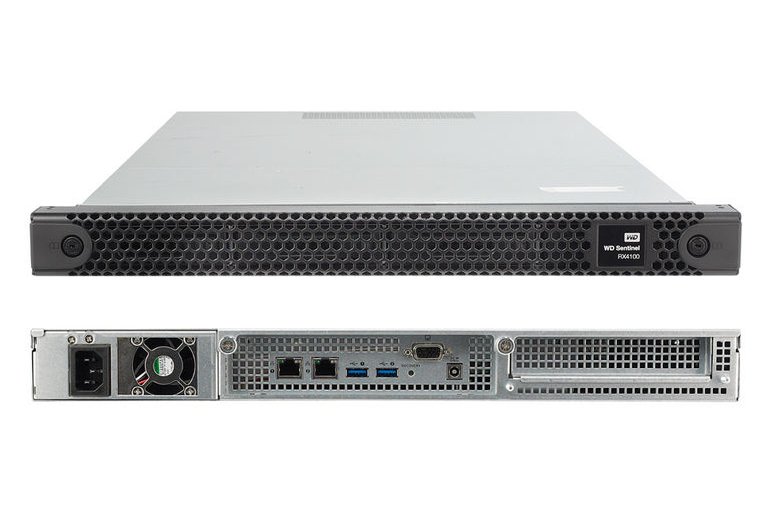
WD’s rack NAS appliance scores well for its client backup and bare metal recovery features. The WSSE 2008 R2 OS is looking old now and the hardware spec is basic but it is easy to use and includes IP SAN support plus optional cloud backup.
-
+
Scheduled workstation backup; Bare metal restore features; Reasonable value
-
-
Windows Storage Server 2008 R2 Essentials is dated

Western Digital has launched the Sentinel RX4100 its first rack mount NAS appliance as it looks to expand beyond the SMB market.
Up until now, its sole offering has been the Sentinel DX4000 four-bay desktop box. WD has taken the motherboard from the DX4000 appliance and dropped it into a full depth 1U rack chassis where it looks minute. It has doubled DDR3 memory to 4GB and added an extra USB2 port at the front but you still get the same 1.8GHz dual-core Atom D525 CPU plus pairs of USB3 and Gigabit ports.
Not available as a diskless model, the RX4100 comes supplied with four SATA hard disks preconfigured in a RAID-5 array. The chassis has a fixed internal 130W PSU and although redundancy is an option, implementation is inelegant. WD has retained one of the power inputs from the DX4000 board so you can add an external power brick.
At its foundation is Windows Storage Server 2008 R2 Essentials (WSSE) which targets small businesses and supports up to 25 users. WSSE is looking long in the tooth but does provide a good range of features including simple file sharing, PC backup and recovery services, secure web access for remote users and integration with Active Directory.
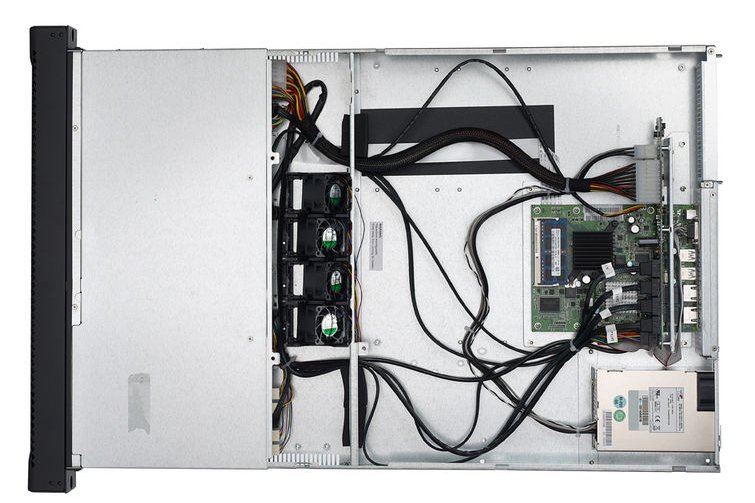
The tiny motherboard looks positively dwarfed in the RX4100 rack chassis
Installation and backup features
Initial deployment was lengthy. With a locally attached monitor, keyboard and mouse, you provide a meaningful name for the appliance plus an admin password and leave WSSE to sort itself out. Add in critical Windows updates and the entire process took over three hours.
Next, you download the Connector and Launchpad software by pointing a web browser at the appliance from each client and following the instructions. For management you can RDP to the appliance but it's easier to use the Dashboard which provides fast access to all WSSE features.
WSSE has a sharp focus on PC backup and recovery and after receiving the Connector, each one pops up in the Dashboard ready for configuration. You can create backups for selected files and folders or complete systems and decide how long to keep daily, weekly and monthly backups.
WSSE uses a daily backup window during which it will try and run as many as possible. This could cause a problem for initial backups as it can only run one at time but subsequent jobs will be faster as it uses VSS snapshots and block level deduplication.
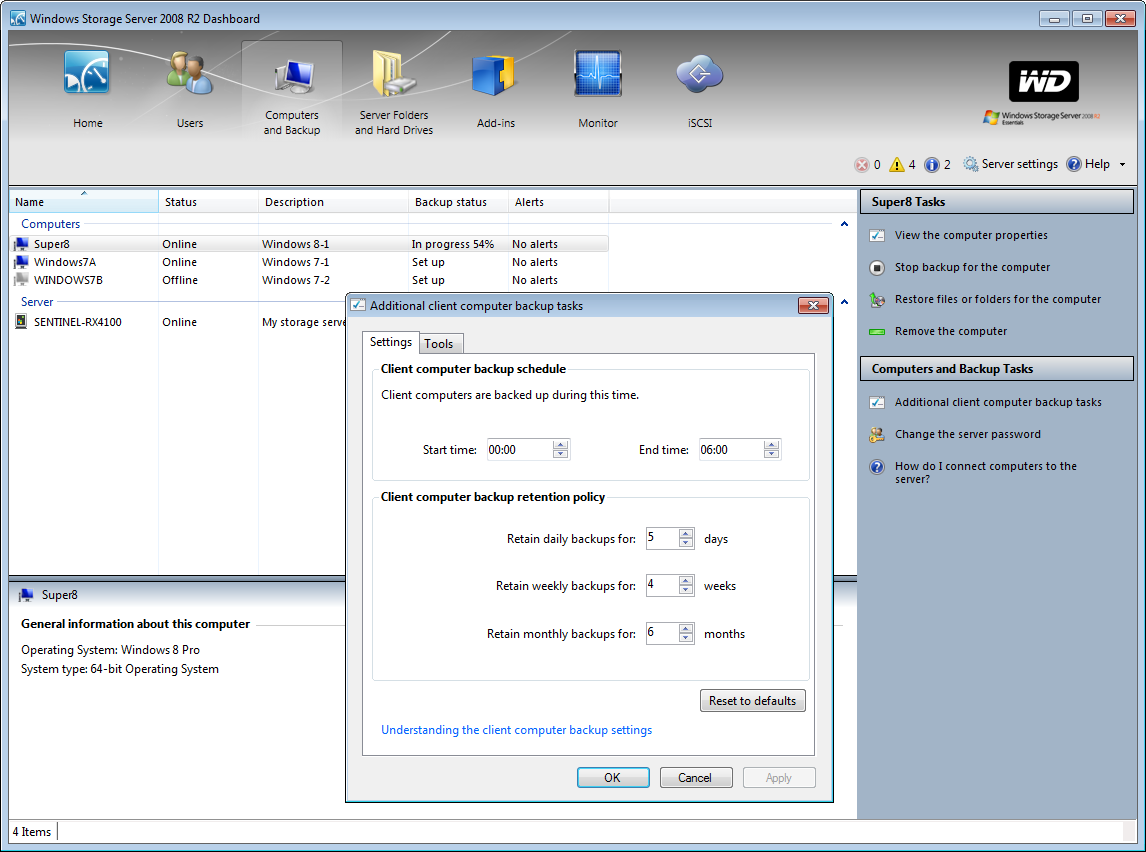
The RX4100 manages all your workstation backup schedules and applies deduplication to reduce storage demands
Add-Ins and performance
You can customise WSSE with extra Add-ins and the RX4100 already has WD's Mac Dashboard and a Connector for remote management via Windows Phone 7 devices. IP SANs are also on the menu as the price includes the StarWinds iSCSI target software.
The extra memory made a difference in our real world performance tests. Drag and drop copies of a 2.52GB video clip returned read and write speeds of 89MB/sec the DX4000 mustered 78MB/sec. General backups are only marginally faster with a 17.4GB folder of 10,500 files copied at 43MB/sec 2MB/sec faster than the DX4000.
Using the WSSE backup service, we secured 47GB on a Windows 8 PC in 50 minutes and deduplication reduced server storage to 29.5GB. For file and folder restoration you select a client from the Dashboard, choose a backup job, pick what you want restored and decide where to send it.
For IP SAN targets you provide a name to append to their IQN, choose a size and decide whether to apply CHAP authentication. Performance is good with Iometer reporting a raw read throughput for a 100GB target of 103MB/sec.
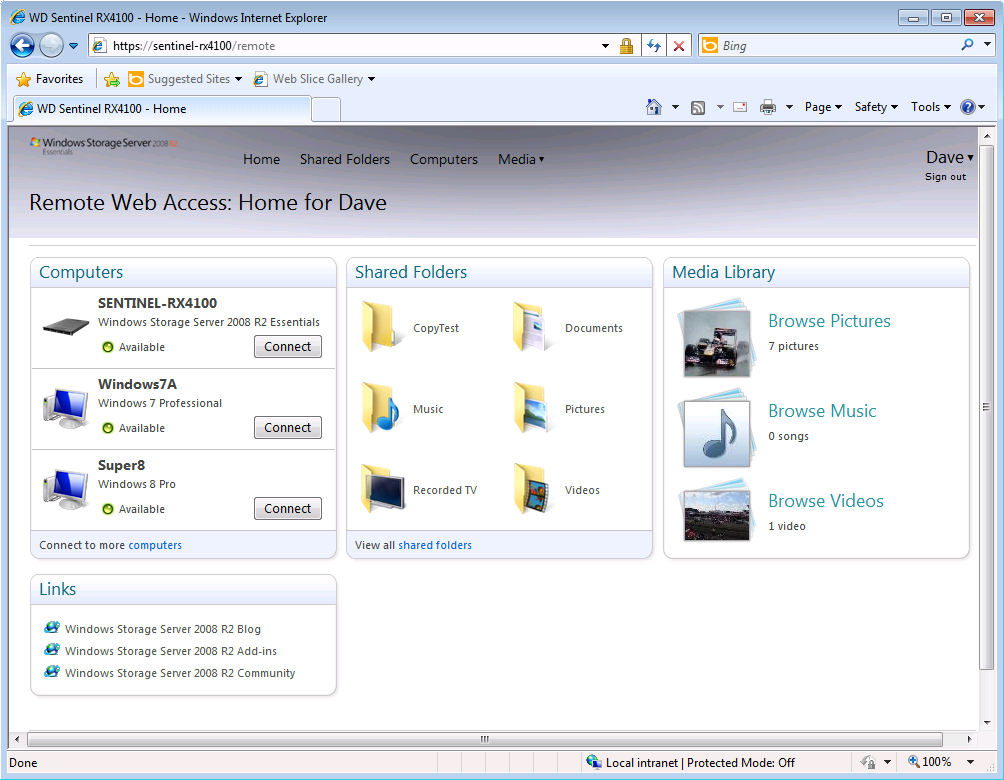
Users log on via the remote web access portal and can view shared folders on the appliance and media libraries
Bare metal recovery and cloud backup
Bare metal recovery is easy to use as you pop a USB stick in the appliance which converts it to a bootable WSSE Full System Restore disk. We tested this with a Windows 8 client where we booted it from the USB stick and used the Windows Full System Restore wizard to reinstate it from the latest backup on the server.
Cloud backup comes courtesy of the AuthenTec KeepVault service which costs around 400 per year for 500GB of storage. It's easy to use as you install the KeepVault Add-in, choose which folders to protect and it does the rest.
Enabling protection on a folder starts a backup and you can request continuous backups, choose a time window and restrict bandwidth usage. We had no problems with real-time protection of a test folder on the RX4100 and whenever we updated a file or added new ones they were copied immediately.
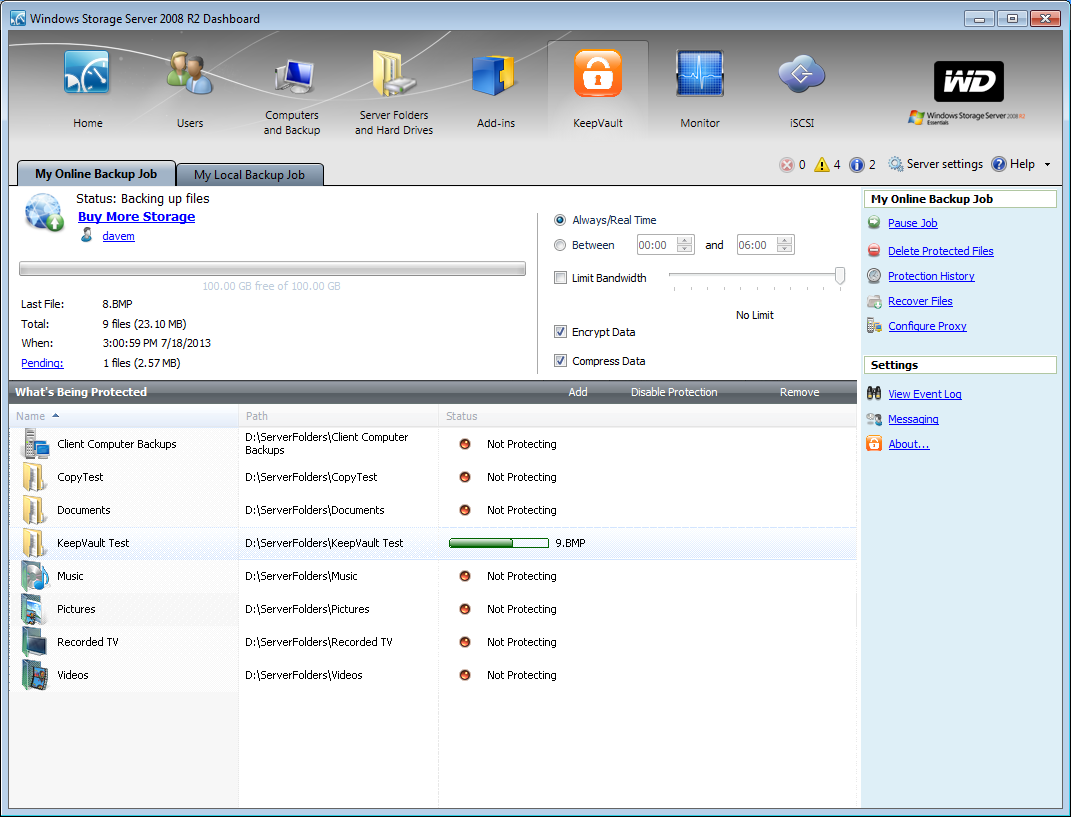
Cloud backup is an optional extra and can be managed easily from the WSSE Dashboard
Conclusion
The Sentinel RX4100 looks good value when stacked up against Qnap's TS-469U-RP although this four-bay alternative comes as standard with dual hot-plug PSUs and offers a lot more storage features. Where the RX4100 scores best, though, is with its workstation backup and bare metal restore facilities which we found very easy to use.
Verdict
WD’s rack NAS appliance scores well for its client backup and bare metal recovery features. The WSSE 2008 R2 OS is looking old now and the hardware spec is basic but it is easy to use and includes IP SAN support plus optional cloud backup.
Chassis: 1U rack
CPU: 1.8GHz Intel Atom D525
Memory: 4GB DDR3
Storage: 4 x 2TB WD SATA II hot-swap hard disks
Array support: RAID-5
Network: 2 x Gigabit
Other ports: 2 x USB3, 1 x USB2
Power: Internal 130W PSU, port for optional external PSU
Management: Web browser, RDP
Software: Windows Storage Server 2008 R2 Essentials preinstalled
Warranty: 3yr limited
Get the ITPro daily newsletter
Sign up today and you will receive a free copy of our Future Focus 2025 report - the leading guidance on AI, cybersecurity and other IT challenges as per 700+ senior executives
Dave is an IT consultant and freelance journalist specialising in hands-on reviews of computer networking products covering all market sectors from small businesses to enterprises. Founder of Binary Testing Ltd – the UK’s premier independent network testing laboratory - Dave has over 45 years of experience in the IT industry.
Dave has produced many thousands of in-depth business networking product reviews from his lab which have been reproduced globally. Writing for ITPro and its sister title, PC Pro, he covers all areas of business IT infrastructure, including servers, storage, network security, data protection, cloud, infrastructure and services.
-
 Women show more team spirit when it comes to cybersecurity, yet they're still missing out on opportunities
Women show more team spirit when it comes to cybersecurity, yet they're still missing out on opportunitiesNews While they're more likely to believe that responsibility should be shared, women are less likely to get the necessary training
By Emma Woollacott Published
-
 OpenAI wants developers using its new GPT-4.1 models – but how do they compare to Claude and Gemini on coding tasks?
OpenAI wants developers using its new GPT-4.1 models – but how do they compare to Claude and Gemini on coding tasks?News OpenAI says its GPT-4.1 model family offers sizable improvements for coding, but tests show competitors still outperform it in key areas.
By Ross Kelly Published
-
 Meta just revived plans to train AI models with European user data – here’s how you can opt out
Meta just revived plans to train AI models with European user data – here’s how you can opt outNews Meta has confirmed plans to train AI models using European users’ public content and conversations with its Meta AI chatbot.
By Nicole Kobie Published